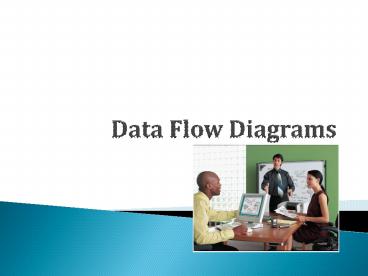Data Flow Diagrams - PowerPoint PPT Presentation
1 / 30
Title:
Data Flow Diagrams
Description:
Title: Data Flow Diagrams Author: gwatkins Last modified by: ch355 Created Date: 10/8/2003 4:29:57 PM Document presentation format: On-screen Show (4:3) – PowerPoint PPT presentation
Number of Views:369
Avg rating:3.0/5.0
Title: Data Flow Diagrams
1
Data Flow Diagrams
2
Data and Process Modeling
- During systems development both processes and
data must be modeled - Data modeling describes data used by system
- Process modeling describes processes carried out
by system - Level of detail
- Varies between highest summary and lowest detail
- Structured tools enable level of detail to be
varied
3
How Many Levels to Use?
- Restrict a single DFD to no more than six to
eight processes - Use another tool to document the lowest level of
detail but use no more than a single page.
B-3
4
Data Flow Diagrams (DFDs)
- Graphic representation of a system that uses a
small number of symbol shapes to illustrate how
data flows through interconnected processes - Most natural way to document processes
- Emphasis on processes rather than data
B-4
5
- Data Flow Diagrams (DFDs) show
- The processes within the system
- The datastores (files) supporting its operation
- The information flows within it
- The system boundary
- Interactions with external entities
6
DFD Symbols
- DFDs consist of four symbols
- 1) Environmental elements called terminators /
external entity - Person
- Organization
- Another system
- 2) Processes which transform inputs to outputs
- Labeled with verb and object
- Also labeled with system or computer program name
B-6
7
DFD Symbols cont.
- DFD symbols cont.
- Data flows which consist of logically related
data elements that travel from one point or
process to another. In other words, data in
motion. - Structures
- Diverge
- Converge
- Data stores which are data repositories. In other
words, data at rest.
B-7
8
DFD symbols
Yourdon
Gane and Sarson
9
A Data Flow
Customer
DFD Symbols
An External Entity
Sales
3
A Process
Check Credit Rating
D1
Credit Rating
A Data Store
10
The Process Symbol
Unique Number
Where its done
Sales
3
Input Data
Check Credit Rating
Output Data
Whats done
11
The data store symbol
D1
Credit Rating
Writing/Updating
Accounts
3
Maintain Credit Rating
Reading
Sales
1
Check Credit Rating
M Manual data Store D Computer File
12
The Data Flow Symbol
Use Meaningful names
Customer Balance
Self Evident Data Flows need not be named
D1
Credit Rating
Sales
3
Check Credit Rating
13
Physical Resource Flow
Customer
Returned Library Book
14
System Boundary
The External Entity Symbol
Customer
A Source and/or sink of data outside the system
boundry
15
DFD naming
- Context Diagram
- Diagram 0
- Child diagram (level 1, 2,,n)
16
(No Transcript)
17
(No Transcript)
18
(No Transcript)
19
LDFD and PDFD
- DFD dikelompokkan menjadi 2
- Logical DFD
- Fokus pada bisnis dan bagaimana bisnis berjalan
- How the system will be constructed
- Physical DFD
- How the system will be implemented
- Include hardware, software, files, people yang
terlibat dalam sistem
20
(No Transcript)
21
Levelling to avoid complex DFDs, processes can
be grouped into higher level processes
2
Dispatch Goods
Process 2.1
Validated Order
1
Dispatch Note
2
22
A Complete DFD
Sales
1
Order
Check Credit Rating
Customer
Rejected Order
D1
Credit Rating
Dispatch Note
Accounts
3
Maintain Credit Ratings
2
Warehouse
Dispatch Goods
23
Repeated Symbols to avoid crossing lines,
data stores and external entities can be repeated
Customer
Customer
A Duplicated External Entity
D1
Credit Rating
Duplicated Data Store
24
DFD Levels
Elementary Functional Description
Level 2
Get cust dets If ordergtcred refer Else
raise order ..
E F D
Level 1
25
Sample
A wines and spirits wholesaler stocks a range of
approximately 400 different lines and delivers by
van on regular weekly runs to customers who are
mainly off-licenses and clubs. The majority of
orders are received by telephone and any one
customer may place several orders during the week
which must be accumulated and delivered in one
consignment. When a customer telephones he
expects to be advised on the availability of an
item requested and, if not in stock, the
alternatives that are available. At present,
sales order forms are filled in by the telephone
salesmen and sent to the warehouse where they are
used for the despatch of the items. Hand-written
despatch notes are used as the basis of the
invoices which are typed and sent by post
sometime later. Prepare a dataflow diagram (DFD)
which represents the above system.
26
Developing Dataflow Diagrams 1. Identify
external entities 2. Draw context diagram 3.
Who/Where does what 4. Identify datastores 5.
Draw diagram
27
- External Entities
- Customer
- Context Diagram
order
advice
customer
company
des. note goods
invoice
28
What Where/who Receive orders Sales Accumu
late orders Sales Advise availability Sales C
omplete Sales Order Form Sales Despatch
Items Warehouse Write despatch
notes Warehouse Type Invoices Warehouse Send
Invoices Warehouse Datastore Stock file
29
customer
Draw DFD
Order
Advice
1
Sales
Stock file
M1
Accumulate orders Advise availability Complete
forms
Sales Order Forms
Warehouse
2
Produce despatch notes Produce Invoices
Invoice
Despatch note goods
customer
30
Extensions Maintenance of Stock File Customer
file address, credit etc Payments Accounts dept
invoices, payments etc Accumulate orders
temporary file

